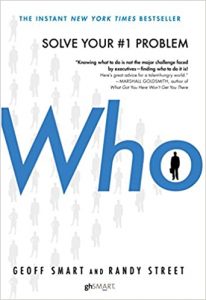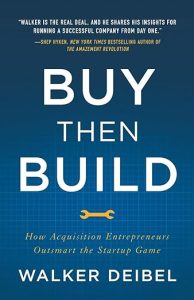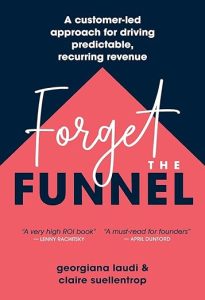I was introduced to Geoff Smart’s “Who” hiring method through a mastermind group.
As you can tell most books I am currently reading are helping me with operational improvements at Carrot.
The following will be a hybrid of a book review and my notes.
Who, not what
The book starts off by informing us how important hiring is. For most organizations, we need to be concerned with getting the right people on the bus and in the right seats. Most organizations struggle to hire because of the following reasons,
- Are not clear about what is needed in a job
- Have a weak flow of candidates
- Do not trust their ability to pick out the right candidate from a group of similar-looking candidates
- Lose candidates they really want to join their team
The 4 Parts Of The Who Hiring Process
- Scorecard – The scorecard is a document that describes exactly what you want a person to accomplish in a role. It is NOT a job description, but rather a set of outcomes and competencies that define a job done well.
- Source – Systematic sourcing before you have slots to fill ensures you have high-quality candidates waiting when you need them.
- Select – Selecting talent in this method involves a series of structured interviews that allow you to gather the relevant facts about a person so you can rate your scorecard and make an informed hiring decision
- Sell – Once you identify people you want on your team through selection, you need to persuade them to join. Selling the right way ensures you avoid the biggest pitfalls that cause the people you want to take a job elsewhere.
Scorecard
Mission, this is the essence of the job. This is an executive summary of the job’s core purpose. It should clearly tell everyone why this role exists in the organization.
Example: To double our revenue over three years by signing large profitable contracts with industrial customers. And to set up one hunting team to land new accounts and one farming team to grow existing accounts.
Don’t hire the generalist. Hire the specialist.
The thinking here is that if your scorecard has a clear mission you should be looking for a candidate with a specific skill set and a track record of completing those outcomes. A generalist will seem great but not be able to fully execute a specific job’s mission.
Outcomes
Outcomes define what must get done. The second part of the scorecard (outcomes) describes what a person must accomplish. These should be quantifiable and attached to numbers that move the company forward.
Avoid listing activities they will perform and instead focus on the output of those activities when executed properly. Everyone wants to do great at their job. But they need to be told what outcomes qualify as great.
Competencies
The third section of the scorecard (competencies) ensures the candidate is a behavior fit. The authors of “Who” conducted a study with the University of Chicago (pg. 29) to analyze their database to determine what competencies ultimately mattered for CEO success. They also asked the many CEOS in their studies to tell them what competencies they felt were most important. The results are below.
Critical competencies for A-players
- Efficiency. Able to produce significant output with minimal wasted effort
- Honest/integrity – Does not cut corners ethically. Earns trust and maintains confidence. Does what is right, not just what is politically expedient. Speaks plainly and truthfully.
- Organization and planning – Plans, organize schedules, and budgets in an efficient, productive manner. Focuses on key priorities.
- Aggressiveness. Moves quickly and takes a forceful stand without being overly abrasive.
- Follow–through on commitments. Lives up to verbal and written agreements, regardless of personal cost.
- Intelligence. Learns quickly. Demonstrates ability to quickly and proficiently understand absorb new information.
- Analytical skills. Able to structure and process qualitative or quantitative data and draw insightful conclusions from it. Exhibit a probing mind and achieves penetrating insights.
- Attention to detail. Does not let important details slip through the cracks or derail a project.
- Persistence. Demonstrates tenacity and willingness to go the distance to get something done.
- Proactivity. Acts without being told what to do. Brings new ideas to the company.
Although these sound great, it’s important to look at what needs added to fit your culture and mission. The book suggests getting leaders into a room and having them add adjectives and definitions to what cultural competencies are expected of team members.
These should be agreed upon and added to the scorecard to ensure all new hires coming into the organization are going to fit well within the culture.
Source
The objective here is to generate a flow of A-players. The 3 ways the book suggests you do this is
- Referrals
- Recruiters
- Researchers
Referrals are the best way to bring talent into an organization. Here is a quote from the book.
The industry leaders we interviewed didn’t speak with one voice on every topic, but on the subject of sourcing new talent through referrals, they were nearly unanimous. Without any prompting from us, a full 77 percent of them cited referrals as their topic technique.
Page 49-50
The book suggests asking this simple question to build your referral network. “Who are the most talented people you know that I should hire?”
Don’t forget how valuable it is to have your employees refer people they know. A-players often know other A-players and if your company allows for them to thrive, they will be happy to bring more team members aboard.
Select
This phase of the book talks about how to structure your interviews to find the A-players. The interview process looks like this
- Screening interview
- Who interview
- Focused interview
- Reference interview
Make sure you document your opinion of a candidate as they progress through these interviews. You can find an example of a hiring scorecard on Geoff Smart’s website here.
The Screening Interview
This is a short, phone based interview designed to remove B and C players from the list. The goal here is to save time by eliminating people who are inappropriate for the position as quickly as possible.
Screening Interview Guide
- What are your career goals?
- What are you really good at professionally?
- What are you not good at or not interested in doing professionally?
- Who were your last five bosses, and how will they reach rate your performance on a 1-10 scale when we talk to them?
How to ask a better follow-up question. I always enjoy learning how people conduct interviews and found this part of the book really interesting. When you are encouraging candidates to share more, try using one of these 3 question starters
- What
- How
- Tell me more
Keep using these starters until you are clear on what they mean.
The Who Interview
The authors of Who put a lot of stock in this part of the hiring process. At it’s core, this is the entire point of the book. They claim…
This style of interviewing is the most valid and reliable predictor of performance, according to a half-century’s worth of thousands of research studies in the field of industrial psychology.
Page 80
Who Interview Guide
Go through each and every job the candidate has put on their resume. Start with the most recent and work your way back.
Tips:
- Feel free to move quickly on jobs that aren’t highly relevant
- Push candidates to answer the questions (don’t let them off the hook)
- Set expectations up front that you are going to ask about their career story and it’ll take 2-3 hours (depending on experience).
Who interview questions. Ask this for each role they have had.
- What were you hired to do?
- What accomplishments are you most proud of?
- What were some low points during that job?
- Who were the people you worked with? Specifically
- What was your boss’s name, and how do you spell that?
- What was it like work with him/her?
- What will he/she tell me were your biggest strengths and areas for improvement?
- How would you rate the team you inherited on an A, B, C scale?
- What changes did you make?
- Did you hire anybody?
- Did you fire anybody?
- How would you rate the team you left it on an A, B, C scale?
- Why did you leave that job?
Tips on some tactics to keep the process running smooth
- Interrupting – you must keep them on track. Learn to master interruption without being rude.
- The 3 P’s – How do you know if their outcome was bad, good or great? Use the 3 P’s. Ask to compare their previous performance, their performance to plan, and their performance compared to their peers.
- Painting a picture – make a candidate paint a picture in your head. Move away from general responses until you really understand what they mean.
- Push vs Pull – Push = “it was mutual”. Pull = “my biggest client hired me”. You are trying to understand if they have been pushed out the door, or pulled into a better opportunity.
- Stopping at the stop signs – look for non-verbal queues that prompt you to dig into more specifics (in a professional and respectful way.)
The Focused Interview
Focused interviews all you to gather additional, specific information about your candidate. In essence you are turning the magnification up another notch so you can give would-be hires one last look with a finer degree of granularity.
It is a good idea to invite team members of this candidate onto the interview.
The additional interviewers should be clear on the following
- This is not a Who interview. Once through their full story is enough.
- They must follow the script
- They must know which questions they are asking and in what order.
The Focused Interview Guide
- The purpose of this interview is to talk about _______________ (fill in the blank with a specific outcome or competency such as the person’s experience selling to new customers.
- What are your biggest accomplishments in this area during your career?
- What are your insights into your biggest mistakes and lessons learned in this area?
The Reference Interview
Here you are looking to check what their previous bosses or team members are going to say about the candidate.
It can be difficult to get on the phone with a previous boss. You should ask the candidate to help set up the interview on your behalf.
Reference Interview Guide
- In what context did you work with the person?
- What were the person’s biggest strengths?
- What were the person’s biggest areas for improvement back then?
- How would you rate his/her overall performance in that job on a scale of 1-10?
- The person mentioned that he/she struggled with ______ in that job. Can you tell me more about that?
If a previous employer rates some a 6 that really means a 2. We are really looking for 8,9s and 10s here.
After you complete the 4 interviews, score your candidates and find the one with the highest marks. This should be an A-player that you can sell on joining your organization.
Common red flags during the hiring process
- The candidate does not mention past failures.
- The candidate exaggerates his or her answers.
- The candidate takes credit for the work of others.
- The candidate speaks poorly of past bosses.
- The candidate cannot explain job moves.
- People most important to the candidate are unsupportive of change
- For managerial hires, the candidate has never had to hire or fire anybody.
- The candidate seems more interested in compensation and benefits than in the job itself.
- The candidate tries too hard to look like an expert.
- The candidate is self-absorbed.
Sell
During this section of the hiring process you must identify what a candidate truly cares about and sell them on how your organization can provide them with that.
The top 5 ways to seal the deal are…
- Fit – ties together the company’s vision, needs, and culture with the candidate’s goals, strengths, and values
- Family – takes into account the broader trauma of changing jobs. What can we do to make this easier for your family?
- Freedom – is autonomy ultimately what they seek? How can you give them the confidence they will be able to make their own decisions.
- Fortune – this reflects the stability of your company the overall financial upside it could present for the candidate.
- Fun – describes the work environment and personal relations the candidate will make.
How To Implement “Who” Hiring Within Your Organization
- Make people the top priority.
- Follow the A Method yourself
- Build support among your executive team or peers.
- Cast a clear vision for the organization and reinforce it through every communication with the broader team.
- Train your team on best practices.
- Remove barriers that impede success
- Implement new policies that support the change.
- Recognize and reward those who use the method and achieve results
- Remove managers who are not on board.
Join The Newsletter
Get occasional emails from me when I publish new projects and articles.



